Wassily Wassilyevich Kandinsky (December 16, 1866 – December 13, 1944) was a Russian artist who is most famous for being a pioneer of abstract art and for painting some of the earliest works in the genre including what is known as the First Abstract Watercolor. Kandinsky began his artistic career around the beginning of the 20th century. Initially, he painted Impressionistic landscapes and woodblock prints. His best known early work is the painting The Blue Rider. With time, Kandinsky came to believe that “objects damaged pictures” and he moved toward abstraction. Art was deeply spiritual for Kandinsky and music was integral to many of his works. He was inspired by color and believed he could convey emotions through it. Kandinsky was one of the most influential painters of the 20th century and he has been called the Father of Abstract Art. Here are his 10 most famous paintings including works from his renowned Composition series.
Note: This post was originally published on August 12, 2016
#10 Composition X

| Location | Kunstsammlung Nordrhein-Westfalen, Dusseldorf, Germany |
| Style | Abstract |
| Year | 1939 |
The idea of music appears everywhere in Kandinsky’s art. For example, he gave many of his paintings musical titles like Compositions, Improvisations and Impressions. The most famous of these are his mighty 10 Compositions, which were created from Composition l in 1907 to Composition X in 1939. The last of the series, Composition X, is regarded as the pinnacle of his exploration of expression through non-representational form. At this time of his career, Kandinsky was influenced by Surrealism and this may be seen in the organic shapes in this painting. The black in the painting allows the colored forms to stand out. Composition X is seen as a representation of the circle of life and the emotional ups and downs that everyone experiences.
#9 On White II

| Location | Georges Pompidou Center, Paris, France |
| Style | Geometric Abstraction |
| Year | 1923 |
Considered a milestone of 20th century modern art, this painting portrays different geometric forms in a magnificent color scheme. Kandinsky used white to represent life, peace and silence. The black in his paintings suggests lack of possibilities. This painting is said to represent the opportunities of life with the color black used to represent death and how all those opportunities can be taken away. The white may also express peace while black may be used to portray nothingness. Kandinsky increasingly utilized geometric motifs in his art in the early 1920s and On White II is among the most famous of his numerous abstract geometrical artworks.
#8 Several Circles
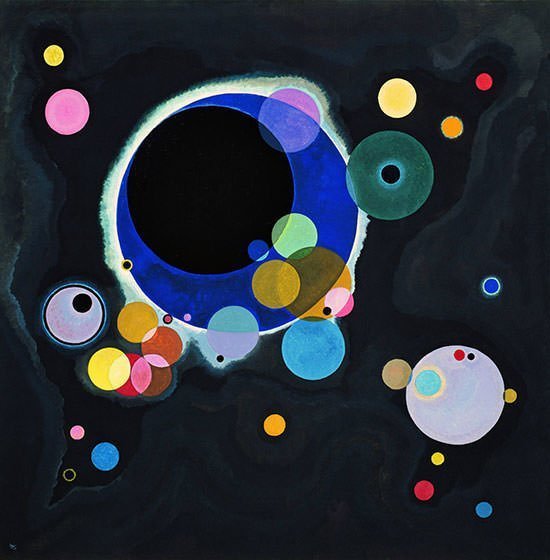
| Location | The Guggenheim, New York, United States |
| Style | Geometric Abstraction |
| Year | 1926 |
In the words of Kandinsky: “The circle is the synthesis of the greatest oppositions. It combines the concentric and the eccentric in a single form and in equilibrium. Of the three primary forms, it points most clearly to the fourth dimension.” In the 1920s, Kandinsky produced a series of 10 pictures in which the circle is the only form. This series culminated in his painting Several Circles, his most important work in capturing the essence of the circle. The painting is a collection of circles carefully positioned on a black background, which enhances their magnitude for the viewer. Several Circles is a prime example of Kandinsky’s focus on the expressive content of abstract forms.
#7 Yellow-Red-Blue

| Location | Georges Pompidou Center, Paris, France |
| Style | Geometric Abstraction |
| Year | 1925 |
Suprematism was a Russian art movement focused on portraying basic geometric forms in a limited range of colors. Bauhaus was a modernist art school in Germany which had a major influence on 20th century art, and where Kandinsky taught from 1922 to 1933. Yellow-Red-Blue, painted by Kandinsky during his time at Bauhaus, can be seen as a symphony he created by merging his style with Bauhaus techniques and Suprematist ideas. It can be divided into two parts with geometric shapes and bright colors on the left and abstract shapes and dark colors on the right. As the title of the painting suggests, Kandinsky has predominantly used the three primary colors, Yellow, Red and Blue.
#6 Upward
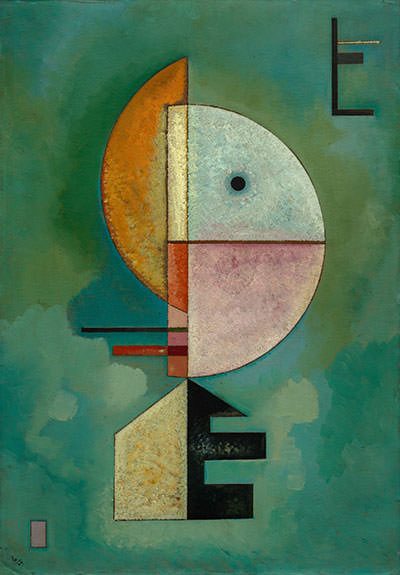
| Location | Peggy Guggenheim Collection, Venice, Italy |
| Style | Geometric Abstraction |
| Year | 1929 |
During his time at Bauhaus, Kandinsky worked with other renowned artists like Paul Klee and Alexej Jawlensky. The physiognomic character of this painting reflects his association with the mentioned artists. The painting is titled Upward as it aims to achieve an effect of energy rising upward. The linear design in the upper right corner echoes the vertical thrust, the dominant idea of the artwork. This configuration resembles the letter E. The letter E may also be seen at the base of the painting in the black cutout. These may be a reference to the German title of the painting, Empor. In German “empor” means “up”. Upward is one of the best known works from the Bauhaus period of Kandinsky.
#5 The Blue Rider
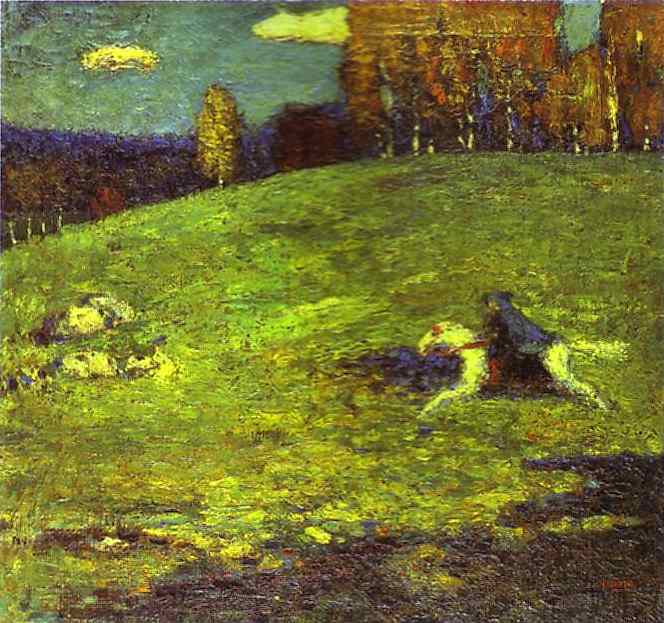
| Location | Private Collection |
| Style | Impressionism |
| Year | 1903 |
The early works of Kandinsky, between 1900 and 1910, were mostly Impressionistic landscapes and woodblock prints. Impressionist artworks focus on capturing the momentary effect of a scene rather than accurately depicting it. The Blue Rider is the most famous painting of Kandinsky in the Impressionistic approach. It is considered a milestone in his transition from Impressionism to Modern Abstract Art. The painting shows a speeding horse rushing through a rocky meadow possibly carrying a second figure, perhaps a child. Kandinsky shows the rider through colors rather than specific details. These techniques of making the user participate in creating the painting through imagination and using color for representation would later be used by Kandinsky in his abstract works.
#4 First Abstract Watercolor
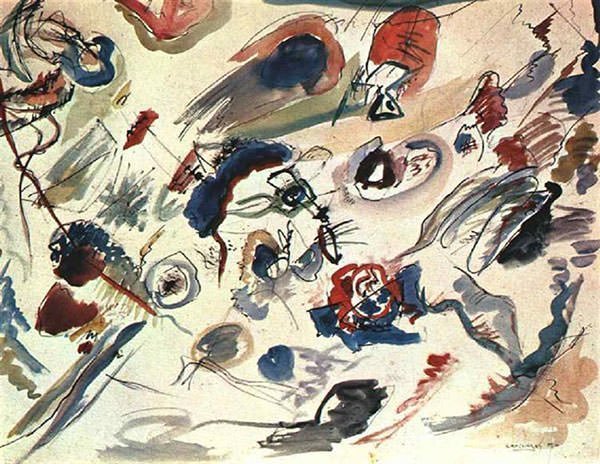
| Location | Georges Pompidou Center, Paris, France |
| Style | Abstract |
| Year | 1910 or 1913 |
This painting was actually left untitled by Wassily Kandinsky. It was a study for his 1913 painting Composition VII. The appropriate title of the work is Untitled (Study for Composition VII, Premiere Abstraction). The artwork is now known as the First Abstract Watercolor because it is credited by many to be the first purely abstract painting. While this might not be necessarily true, it is beyond doubt that this painting is one of the first to shed all references to well known forms in the representational tradition of Western European painting. It is the first extant entry in Kandinsky’s parallel series of abstract “Compositions” and “Improvisations”. Though critics wouldn’t regard it as one of his best works, First Abstract Watercolor is definitely one of the most famous paintings of Kandinsky; the one which makes him the Father of Abstract Act in popular belief.
#3 Color Study: Squares with Concentric Circles
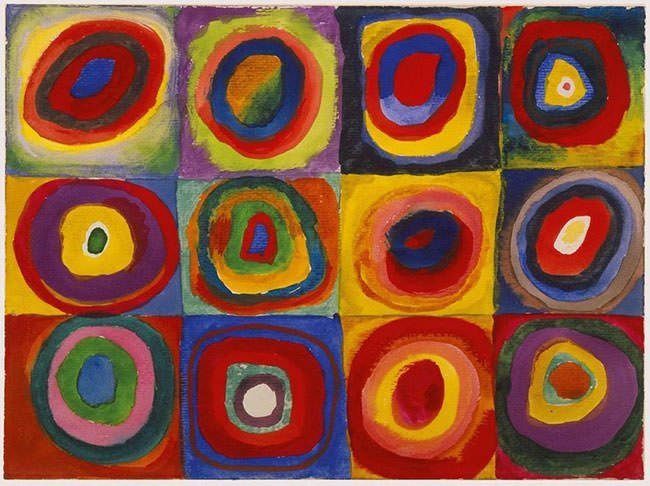
| Location | Lenbachhaus, Munich, Germany |
| Style | Abstract |
| Year | 1913 |
Kandinsky believed that color induces a physical and an emotional response. This response depends on how color is used in relationship to form in a painting. Moreover, according to him an artist could create a unified composition in which actions, secret thoughts and feelings could be visualized in a spiritual atmosphere of color. Thus Kandinsky explored the emotional and expressionistic qualities of colors in many paintings. This painting is his most famous color study and perhaps his most recognizable artwork. It plots out color combinations within concentric circular patterns arranged in an all over grid format. Also known as Farbstudie Quadrate, it can be seen as an organized investigation of perceptual effects of the interactions of colors and the emotional effect contrasting colors produce.
#2 Composition VIII
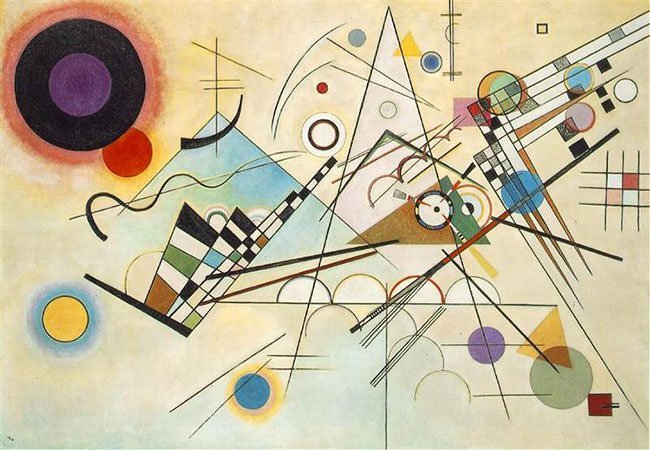
| Location | The Guggenheim, New York, United States |
| Style | Geometric Abstraction |
| Year | 1923 |
Suprematism was a Russian art movement which focused on portraying basic geometric forms in a limited range of colors. Constructivism was an art movement marked by constructing objects in artworks that didn’t exist in the world. This painting is a synthesis of elements from Suprematism, Constructivism and the Bauhaus school; and illustrates Kandinsky’s command over modern art of the time. Composition VIII features a selection of geometric forms interacting with linear elements. With its rational geometric order, it is the polar opposite to the previous painting of the series, Composition VII. While Composition VII is an explosion of color and emotion, Composition VIII is a much more controlled artwork. The multi-colored circles in the painting may have been inspired by the six solar eclipses between 1921 and 1923. Composition VIII is the most famous artwork of Kandinsky in Geometric Abstraction as well as the high point of his postwar achievement.
#1 Composition VII
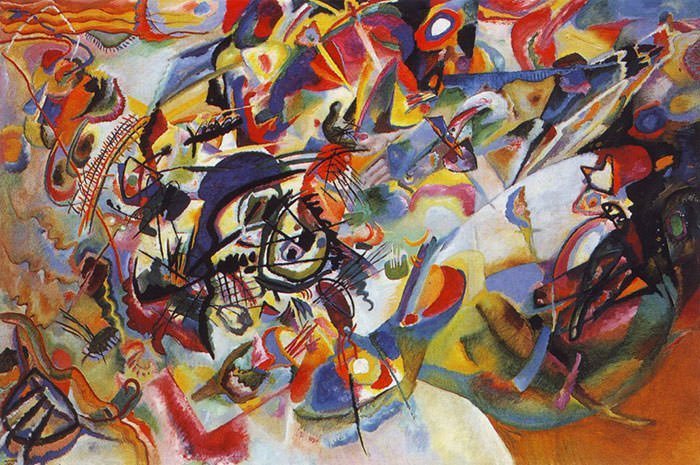
| Location | Tretyakov Gallery, Moscow, Russia |
| Style | Abstract |
| Year | 1913 |
Composition VII is so renowned because it was the first time Kandinsky felt that he had achieved the ideal for which his Composition series was named. He moved toward complete abstraction in his earlier Compositions and Composition VI is almost totally abstract. Composition VII translates the abstract imagery of its predecessor into a purely geometric visual language. Though it might appear random, Kandinsky created over 30 sketches in several months prior to painting it, which he did in four days. The painting is believed to allude to the apocalyptic themes of Deluge, Last Judgment, Resurrection and Paradise. It was regarded by Kandinsky as his most complex work. A swirling hurricane of colors and shapes, Composition VII is considered by abstract art enthusiasts as the most important painting in the genre and it is Wassily Kandinsky’s most famous painting.


“JUSTICE SHALL PREVAIL”
The above are certainly the most impressive 10 special works by Wassily Kandinsky.
In totality, it is his aspiration that “JUSTICE SHALL PREVAIL” in the society at all levels and structures.
“JUSTICE SHALL PREVAIL” is perhaps, the central theme in all these 10 paintings above…..
JEONG CHUN PHUOC,PHD
adj prof and visiting prof
hi hi art fanatics